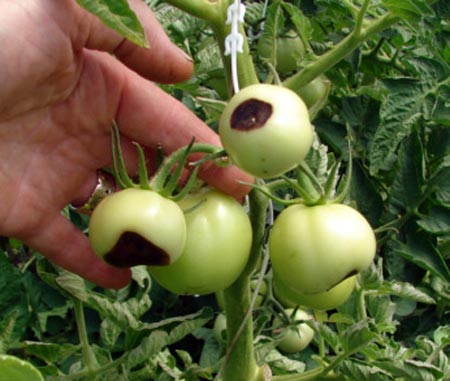Blossom end rot: Understanding a perennial problem
Blossom end rot is a perennial problem on tomatoes, peppers and other crops. Understanding the causes can help reduce symptoms, but it is rare to be able to eliminate it completely.
Blossom end rot is a perennial problem for many fruit and vegetable growers. Vegetables especially susceptible to blossom end rot are tomatoes (Photo 1), Roma-types in particular, peppers, eggplant, watermelon and summer squash. Very simply, blossom end rot is caused by a lack of adequate calcium (Ca) in the fruit with the Ca concentration being lower at the blossom end compared to the stem end. Blossom end rot is more prevalent on early fruit than it is on later fruit and varieties can vary in their susceptibility. Calcium is an important nutrient needed by plants for cell wall development and other processes. Calcium is non-mobile in the plant, meaning that once it is in place in the plant, it cannot be moved to another area within the plant. Therefore, plants need a continual Ca supply for good growth. On tomatoes, blossom end rot is often in combination with a black, sooty appearing fungus that is a secondary problem. The solution to minimizing blossom end rot lies in understanding the reasons plants might have difficulty in maintaining adequate Ca.

Photo 1. Blossom end rot of tomato. Photo credit: Ron Goldy, MSU Extension
The first reason plants lack Ca is that there may not be enough Ca in the soil. Inadequate Ca can be quickly determined by a soil test. Michigan State University Extension indicates soil tests can be done in the fall and if corrective measures are needed, fall is a great time to add Ca as lime. Another plus is soil testing labs are often not as busy in the fall, so results may be returned sooner. Low Ca can be accompanied by low magnesium, in which dolomitic lime can be applied. Adding standard or dolomitic lime will increase soil pH. Some situations may require additional Ca, but not increased pH, in which gypsum will be recommended. Gypsum is calcium sulfate and will not change pH. Most Michigan soils, whether they are sand or clay-based, generally have adequate Ca, but lime may need to be added to adjust pH.
Another reason plants may be unable to maintain a steady Ca supply is inconsistent water. Alternating wet and dry periods decrease Ca uptake and greatly contribute to blossom end rot development. Timely irrigation maintains consistent soil moisture, insuring an uninterrupted flow of Ca into the plant, which can happen even though there are adequate Ca levels in the soil.
Strangely enough, another factor contributing to blossom end rot is excellent growing conditions. A period of bright sunshine and warm temperatures often experienced in July can be a main contributor. So even with adequate soil Ca and soil moisture, weather conditions can work against you. I have seen this especially in peppers. Excellent growing conditions apparently cause plants to grow so rapidly that roots are unable to take up enough Ca to meet demand and the blossom end of the fruit is the first to suffer.
I often get calls about foliar Ca applications and I always tell the caller that plants best get Ca through their roots, and foliar applications are only a short-term fix. As stated earlier, Ca is not very mobile in the plant, so application to older leaves has little benefit. If foliar applications are done, it is important to apply them to young, expanding leaves. Products of choice are calcium chloride or calcium nitrate at 1 to 2 pounds of Ca in 30 gallons of water. Read more information on secondary and micronutrient applications.
It is not possible to completely eliminate blossom end rot since some causal agents are beyond your control, but it can be greatly reduced by making sure soil Ca levels are adequate, proper irrigation practices are followed, good variety selection and foliar Ca are timely and properly applied.



 Print
Print Email
Email

